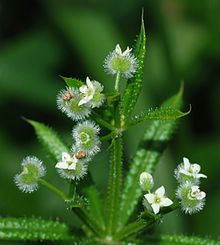- Galium aparine
-
Galium aparine 
Galium aparine in flower Scientific classification Kingdom: Plantae (unranked): Angiosperms (unranked): Eudicots (unranked): Asterids Order: Gentianales Family: Rubiaceae Genus: Galium Species: G. aparine Binomial name Galium aparine
L.Galium aparine is a herbaceous annual plant of the family Rubiaceae. It is native to North America and Eurasia. It has several common names, including Cleavers, Clivers, Goosegrass, Stickywilly, Stickyjack, Stickyweed, Stickyleaf, Catchweed, Robin-run-the-hedge and Coachweed.
Contents
Growth
The long stems of this climbing plant sprawl over the ground and other plants, reaching heights of 1-1.5 m, occasionally 2 m. The leaves are simple and borne in whorls of six to eight. Both leaves and stem have fine hairs tipped with tiny hooks, making them cling to clothes and fur much like velcro. The white to greenish flowers are 2-3 mm across, with four petals.
It flowers in early spring to summer, with the flowers occurring in most of the leaf nodes. The fruits are clustered 1-3 seeds together; each seed is 4-6 mm diameter, and is also covered with hooked hairs (a burr) which cling to animal fur, aiding in seed dispersal.
It is a common weed in hedges and other low shrubby vegetation, and is also a common weed in arable fields, as well as gardens. As they grow quite rampantly and thickly, they end up shading out any small plants that they overrun.
The seeds are similar in size to cereal grains, and so are a common contaminant in cereals since they are difficult to filter out. The presence of some seed in cereals is not considered a serious problem as they are not toxic.
Uses
When dried and roasted, the fruits of this plant can be used to make a coffee-like drink. The plant can also be made into a tea.
In Sweden the plant's stalk was traditionally used to strain milk. [1]
Herbalism
The plant was traditionally used to treat skin diseases.[citation needed] Herbalists believe that it lowers blood pressure and body temperature, use it for cystitis.[2] The whole plant is considered rich in vitamin C.[citation needed] Its roots produce a red dye, and the tea has been used as an anti-perspirant (by the Chinese), and as a relief for head colds (home remedy), restlessness, and sunburns.[citation needed] As a pulp, it has been used to relieve poisonous bites. [3]
Edibility
Galium aparine is edible. The numerous small hooks which cover the plant and give it its clinging nature make it unfit to be eaten raw. However boiled as a leaf vegetable before the fruits appear it makes tolerable eating. [4] [5]
Notes
- ^ Loudon, John Claudius. "An encyclopædia of plants", 1836, p. 93
- ^ Howard, Michael. Traditional Folk Remedies (Century, 1987) pp. 145-6
- ^ Jones, Pamela. Just Weeds: History, Myths, and Uses. Prentice Hall Press, New York. 1991.
- ^ R. Mabey, Food for Free
- ^ Edible Wild Plants: A North American Field Guide
Edible and Medicinal Plants of the West, Gregory L. Tilford, ISBN 0-87842-359-1
External links
- Image Archive of Central Texas Plants
- Missouriplants.com - a site with additional information and excellent pictures.
- Edibility of Cleavers: Edible parts and identification of Galium aparine
Categories:- Medicinal plants
- Galium
Wikimedia Foundation. 2010.
